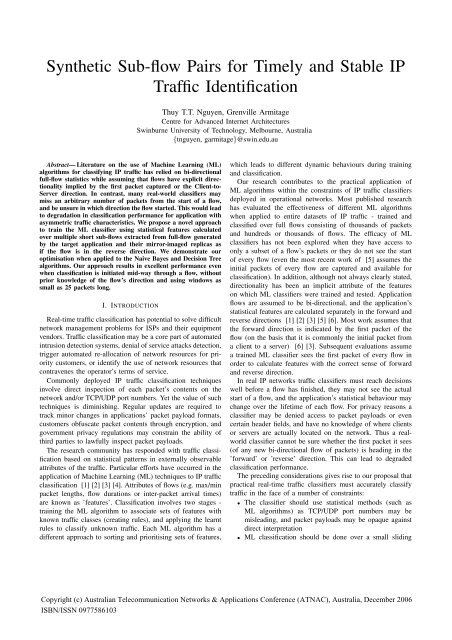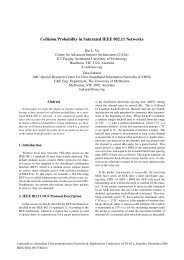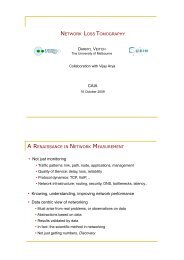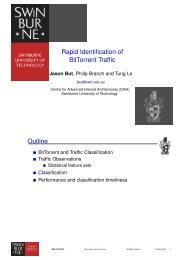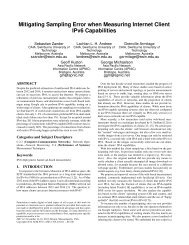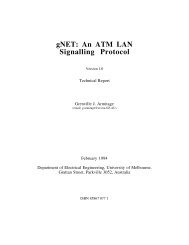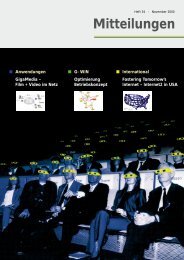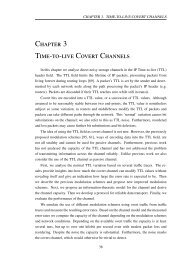Synthetic Sub-flow Pairs for Timely and Stable IP Traffic Identification
Synthetic Sub-flow Pairs for Timely and Stable IP Traffic Identification
Synthetic Sub-flow Pairs for Timely and Stable IP Traffic Identification
You also want an ePaper? Increase the reach of your titles
YUMPU automatically turns print PDFs into web optimized ePapers that Google loves.
<strong>Synthetic</strong> <strong>Sub</strong>-<strong>flow</strong> <strong>Pairs</strong> <strong>for</strong> <strong>Timely</strong> <strong>and</strong> <strong>Stable</strong> <strong>IP</strong><br />
<strong>Traffic</strong> <strong>Identification</strong><br />
Abstract— Literature on the use of Machine Learning (ML)<br />
algorithms <strong>for</strong> classifying <strong>IP</strong> traffic has relied on bi-directional<br />
full-<strong>flow</strong> statistics while assuming that <strong>flow</strong>s have explicit directionality<br />
implied by the first packet captured or the Client-to-<br />
Server direction. In contrast, many real-world classifiers may<br />
miss an arbitrary number of packets from the start of a <strong>flow</strong>,<br />
<strong>and</strong> be unsure in which direction the <strong>flow</strong> started. This would lead<br />
to degradation in classification per<strong>for</strong>mance <strong>for</strong> application with<br />
asymmetric traffic characteristics. We propose a novel approach<br />
to train the ML classifier using statistical features calculated<br />
over multiple short sub-<strong>flow</strong>s extracted from full-<strong>flow</strong> generated<br />
by the target application <strong>and</strong> their mirror-imaged replicas as<br />
if the <strong>flow</strong> is in the reverse direction. We demonstrate our<br />
optimisation when applied to the Naive Bayes <strong>and</strong> Decision Tree<br />
algorithms. Our approach results in excellent per<strong>for</strong>mance even<br />
when classification is initiated mid-way through a <strong>flow</strong>, without<br />
prior knowledge of the <strong>flow</strong>’s direction <strong>and</strong> using windows as<br />
small as 25 packets long.<br />
I. INTRODUCTION<br />
Real-time traffic classification has potential to solve difficult<br />
network management problems <strong>for</strong> ISPs <strong>and</strong> their equipment<br />
vendors. <strong>Traffic</strong> classification may be a core part of automated<br />
intrusion detection systems, denial of service attacks detection,<br />
trigger automated re-allocation of network resources <strong>for</strong> priority<br />
customers, or identify the use of network resources that<br />
contravenes the operator’s terms of service.<br />
Commonly deployed <strong>IP</strong> traffic classification techniques<br />
involve direct inspection of each packet’s contents on the<br />
network <strong>and</strong>/or TCP/UDP port numbers. Yet the value of such<br />
techniques is diminishing. Regular updates are required to<br />
track minor changes in applications’ packet payload <strong>for</strong>mats,<br />
customers obfuscate packet contents through encryption, <strong>and</strong><br />
government privacy regulations may constrain the ability of<br />
third parties to lawfully inspect packet payloads.<br />
The research community has responded with traffic classification<br />
based on statistical patterns in externally observable<br />
attributes of the traffic. Particular ef<strong>for</strong>ts have occurred in the<br />
application of Machine Learning (ML) techniques to <strong>IP</strong> traffic<br />
classification [1] [2] [3] [4]. Attributes of <strong>flow</strong>s (e.g. max/min<br />
packet lengths, <strong>flow</strong> durations or inter-packet arrival times)<br />
are known as ’features’. Classification involves two stages -<br />
training the ML algorithm to associate sets of features with<br />
known traffic classes (creating rules), <strong>and</strong> applying the learnt<br />
rules to classify unknown traffic. Each ML algorithm has a<br />
different approach to sorting <strong>and</strong> prioritising sets of features,<br />
Thuy T.T. Nguyen, Grenville Armitage<br />
Centre <strong>for</strong> Advanced Internet Architectures<br />
Swinburne University of Technology, Melbourne, Australia<br />
{tnguyen, garmitage}@swin.edu.au<br />
which leads to different dynamic behaviours during training<br />
<strong>and</strong> classification.<br />
Our research contributes to the practical application of<br />
ML algorithms within the constraints of <strong>IP</strong> traffic classifiers<br />
deployed in operational networks. Most published research<br />
has evaluated the effectiveness of different ML algorithms<br />
when applied to entire datasets of <strong>IP</strong> traffic - trained <strong>and</strong><br />
classified over full <strong>flow</strong>s consisting of thous<strong>and</strong>s of packets<br />
<strong>and</strong> hundreds or thous<strong>and</strong>s of <strong>flow</strong>s. The efficacy of ML<br />
classifiers has not been explored when they have access to<br />
only a subset of a <strong>flow</strong>’s packets or they do not see the start<br />
of every <strong>flow</strong> (even the most recent work of [5] assumes the<br />
initial packets of every <strong>flow</strong> are captured <strong>and</strong> available <strong>for</strong><br />
classification). In addition, although not always clearly stated,<br />
directionality has been an implicit attribute of the features<br />
on which ML classifiers were trained <strong>and</strong> tested. Application<br />
<strong>flow</strong>s are assumed to be bi-directional, <strong>and</strong> the application’s<br />
statistical features are calculated separately in the <strong>for</strong>ward <strong>and</strong><br />
reverse directions [1] [2] [3] [5] [6]. Most work assumes that<br />
the <strong>for</strong>ward direction is indicated by the first packet of the<br />
<strong>flow</strong> (on the basis that it is commonly the initial packet from<br />
a client to a server) [6] [3]. <strong>Sub</strong>sequent evaluations assume<br />
a trained ML classifier sees the first packet of every <strong>flow</strong> in<br />
order to calculate features with the correct sense of <strong>for</strong>ward<br />
<strong>and</strong> reverse direction.<br />
In real <strong>IP</strong> networks traffic classifiers must reach decisions<br />
well be<strong>for</strong>e a <strong>flow</strong> has finished, they may not see the actual<br />
start of a <strong>flow</strong>, <strong>and</strong> the application’s statistical behaviour may<br />
change over the lifetime of each <strong>flow</strong>. For privacy reasons a<br />
classifier may be denied access to packet payloads or even<br />
certain header fields, <strong>and</strong> have no knowledge of where clients<br />
or servers are actually located on the network. Thus a realworld<br />
classifier cannot be sure whether the first packet it sees<br />
(of any new bi-directional <strong>flow</strong> of packets) is heading in the<br />
’<strong>for</strong>ward’ or ’reverse’ direction. This can lead to degraded<br />
classification per<strong>for</strong>mance.<br />
The preceding considerations gives rise to our proposal that<br />
practical real-time traffic classifiers must accurately classify<br />
traffic in the face of a number of constraints:<br />
• The classifier should use statistical methods (such as<br />
ML algorithms) as TCP/UDP port numbers may be<br />
misleading, <strong>and</strong> packet payloads may be opaque against<br />
direct interpretation<br />
• ML classification should be done over a small sliding<br />
Copyright (c) Australian Telecommunication Networks & Applications Conference (ATNAC), Australia, December 2006<br />
ISBN/ISSN 0977586103
window of the last N packets (to keep memory requirements<br />
down <strong>and</strong> per<strong>for</strong>m classification in a timely<br />
manner)<br />
• The classifier must recognise <strong>flow</strong>s already in progress<br />
(the <strong>flow</strong>’s beginning may be missed)<br />
• Application’s can change their network traffic patterns<br />
over time<br />
• The classifier doesn’t have to know about the direction<br />
the original <strong>flow</strong> traverses, it can assume the <strong>for</strong>ward<br />
direction is the direction of the 1st packet of most recent<br />
N packets it captured, regardless if it is from client to<br />
server or server to client.<br />
We have previously demonstrated a novel approach to ML<br />
classification that meets the first four requirements [7]. We<br />
proposed training the classifier on a combination of short<br />
sub-<strong>flow</strong>s extracted from full-<strong>flow</strong> examples of the target<br />
application’s traffic. Our approach resulted in excellent per<strong>for</strong>mance<br />
while allowing the sliding window classifier to properly<br />
identify an application regardless of where within a <strong>flow</strong> the<br />
classifier begins capturing packets.<br />
This paper extends our work in [7] to address the last<br />
requirement listed above. We propose <strong>and</strong> demonstrate a novel<br />
modification: The ML classifier is trained using statistical<br />
features calculated over multiple short sub-<strong>flow</strong>s (as in [7])<br />
<strong>and</strong> their mirror-imaged replicas (multiple ’synthetic sub<strong>flow</strong><br />
pairs’). The sub-<strong>flow</strong>s are picked from regions of the<br />
application’s full <strong>flow</strong>s that have noticeably different statistical<br />
characteristics, <strong>and</strong> coupling with their mirrored replicas as if<br />
they are travelling in the reverse direction.<br />
We demonstrate the benefit of our proposal when applied<br />
to two different supervised learning ML algorithms, C4.5<br />
Decision Tree <strong>and</strong> Naive Bayes. We utilise a hypothetical<br />
classification scenario where real-time <strong>flow</strong>s belonging to the<br />
online multiplayer game Wolfenstein Enemy Territory (ET)<br />
[8] must be dynamically detected while mixed in amongst<br />
thous<strong>and</strong>s of unrelated, interfering traffic <strong>flow</strong>s. We characterise<br />
the classification per<strong>for</strong>mance of each ML algorithm as<br />
a function of the location of the sliding window relative to<br />
the actual beginning of an application <strong>flow</strong> <strong>and</strong> the apparent<br />
’direction’ of a <strong>flow</strong>.<br />
Our paper is organised as following. Section II briefly<br />
summarizes keys components of our proposal. Section III<br />
describes our experimental demonstration of our proposal,<br />
with our results analysed in section IV. Section V describes<br />
some future research directions <strong>and</strong> concludes our paper.<br />
II. OUR PROPOSAL<br />
We present an improved technique <strong>for</strong> training <strong>and</strong> using<br />
ML classifiers such that <strong>IP</strong> <strong>flow</strong>s can be classified in finite<br />
periods of time <strong>and</strong> without regard to inferred or actual<br />
directionality of <strong>flow</strong> or the number of packets missed from<br />
the beginning of a <strong>flow</strong>. We propose that realistic ML-based<br />
traffic classification tools should:<br />
• Operate the ML classifier using a sliding-window over<br />
each <strong>flow</strong> - we presume the classifier can see (or must<br />
use) no more than the most recent N consecutive packets<br />
of a <strong>flow</strong> (an N-packet sub-<strong>flow</strong>) at any given time.<br />
• Train the ML classifier using sets of features calculated<br />
from multiple sub-<strong>flow</strong>s. The sets of training sub-<strong>flow</strong>s<br />
are created in two steps: (a) Take short sequences of N<br />
consecutive packets from different points within examples<br />
of the target application’s <strong>flow</strong>s (a sub-<strong>flow</strong>), <strong>and</strong> then (b)<br />
create mirror-imaged replicas of each packet sequence<br />
with the directions reversed (a mirrored sub-<strong>flow</strong>).<br />
Training the classifier on multiple sub-<strong>flow</strong>s of size N<br />
packets maximises the classifier’s ability to recognise an<br />
application <strong>flow</strong> even when exposed to only a small window of<br />
traffic from the <strong>flow</strong>. Each sub-<strong>flow</strong> is taken from places in the<br />
original <strong>flow</strong> having noticeably different statistical properties<br />
(<strong>for</strong> example, the start <strong>and</strong> middle of the <strong>flow</strong>) [7].<br />
Also training on mirrored replicas of each sub-<strong>flow</strong> is the<br />
key contribution of this paper. Doing so enables the classifier<br />
to recognise an application’s traffic in either direction. This<br />
is an important step - as packets <strong>flow</strong> through the classifier’s<br />
sliding window the first packet can alternately represent traffic<br />
in the Client to Server (C-S) or Server to Client (S-C) direction.<br />
To ensure the classifier need not make that distinction,<br />
we train the classifier to recognise the application in either<br />
direction.<br />
III. ILLUSTRATING OUR EXPERIMENTAL APPROACH<br />
A. Machine Learning Algorithms <strong>and</strong> Teminology<br />
In this paper we use the Naive Bayes [9] <strong>and</strong> C4.5 Decision<br />
Tree [10] implementations in WEKA tools [11]. These are<br />
well-understood supervised-learning algorithms with different<br />
internal training <strong>and</strong> classification mechanisms. Testing our<br />
proposal with both algorithms reveals benefits in either case,<br />
suggesting our proposal is applicable to more than just one<br />
particular type of ML algorithm. (Due to space limitations we<br />
refer readers to [12] <strong>for</strong> further details of these algorithms.)<br />
Recall <strong>and</strong> Precision are two metrics often used to evaluate<br />
the per<strong>for</strong>mance of ML classification algorithms. If a classifier<br />
is trained to identify members of class X, Recall refers to the<br />
proportion of class X’s instances which are correctly classified<br />
as belonging to class X <strong>and</strong> Precision refers to the proportion<br />
of the instances which truly have class X among all those<br />
classified as class X. Both metrics range from 0 (poor) to<br />
100% (optimal). While using both, it is important to note that<br />
high Precision only is meaningful when the classifier achieves<br />
good Recall.<br />
B. Flows <strong>and</strong> Features<br />
Full-Flows are bidirectional streams of packets between<br />
a given pair of hosts, defined by the source <strong>and</strong> destination<br />
<strong>IP</strong> addresses, port numbers <strong>and</strong> protocol. The C-S direction<br />
determines the ’<strong>for</strong>ward’ direction. Flow timeout is used as<br />
specified in [6]. Each sub-<strong>flow</strong> is a fragment of N consecutive<br />
packets (bi-directional) taken from different points within the<br />
original application <strong>flow</strong>’s lifetime. Its <strong>for</strong>ward direction is<br />
defined the same as full-<strong>flow</strong>: C-S direction. The <strong>Synthetic</strong><br />
<strong>Sub</strong>-Flow pairs consists of the sub-<strong>flow</strong>s <strong>and</strong> their synthetic<br />
Copyright (c) Australian Telecommunication Networks & Applications Conference (ATNAC), Australia, December 2006<br />
ISBN/ISSN 0977586103
pairs, whose statistical properties are the same as the sub-<strong>flow</strong>s<br />
except they are swapped <strong>for</strong> backward <strong>and</strong> <strong>for</strong>ward directions<br />
(as being calculated with the <strong>for</strong>ward direction of the sub-<strong>flow</strong><br />
is defined as the reverse direction: S-C).<br />
For full-<strong>flow</strong>, sub-<strong>flow</strong> <strong>and</strong> synthetic sub-<strong>flow</strong> pairs models,<br />
we trained <strong>and</strong> classified the classifier using the following<br />
features, calculated separately in the <strong>for</strong>ward <strong>and</strong> backward<br />
directions: Inter-packet arrival interval, Inter-packet length<br />
variation <strong>and</strong> <strong>IP</strong> packet length; all with minimum, maximum,<br />
mean <strong>and</strong> st<strong>and</strong>ard deviation values. These features are calculated<br />
based on the framework of Netmate tool [13].<br />
For testing the classifier we assume that the classifier defines<br />
the <strong>for</strong>ward direction as the first packet of a <strong>flow</strong> that it could<br />
capture, regardless whether it is from C-S or S-C.<br />
C. Construction of training <strong>and</strong> testing datasets<br />
To show the effectiveness of our proposed approach we<br />
use completely different datasets <strong>for</strong> training <strong>and</strong> testing our<br />
classifiers. The game traffic consists of two separate monthlong<br />
traces collected during May <strong>and</strong> September 2005 at a<br />
public ET server in Australia [14]. Our interfering (non-<br />
ET) traffic came from two 24-hour traces collected by the<br />
University of Twente, Germany, on February 6th <strong>and</strong> 7th 2004<br />
[15](named T1 <strong>and</strong> T2 respectively). They include a large<br />
range of common applications (HTTP, HTTPS, DNS, NTP,<br />
SMTP, IMAP, POP3, Telnet, SSH, HalfLife, Kazaa, Bittorrent,<br />
Gnutella, eDonkey). As payloads were missing we inferred<br />
application type from the port numbers (judged an acceptable<br />
approach because our primary criteria <strong>for</strong> interfering traffic is<br />
that it was not ET). For each application’s default port(s) we<br />
sampled a maximum of 10000 <strong>flow</strong>s per raw tracefile.<br />
For each experiment we trained our classifiers using a mix<br />
of ET traffic from May dataset <strong>and</strong> interfering traffic from T2<br />
(sub-<strong>flow</strong>s are extracted from 8,688 full-<strong>flow</strong>s <strong>for</strong> ET mixed<br />
with 82,957 full-<strong>flow</strong>s in T2). <strong>Sub</strong>sequent testing of each<br />
classifier scenario was per<strong>for</strong>med using a mix of ET traffic<br />
(N packets extracted from 6,888 full-<strong>flow</strong>s) from September<br />
<strong>and</strong> traffic from T1 (N packets extracted from a mixture of<br />
73,672 full-<strong>flow</strong>s). Further details can be found in [7].<br />
D. Statistical properties of ET traffic<br />
Packet Length Stddev.(bytes)<br />
0 200 400 600 800<br />
Full Flow<br />
In Game<br />
0 400 800 1200<br />
Mean Packet Length (S−C) (bytes)<br />
Packet Length Stddev.(bytes)<br />
0 50 100 150<br />
Full Flow<br />
In Game<br />
0 100 300<br />
Mean Packet Length (C−S) (bytes)<br />
Fig. 1. Packet Length from S-C <strong>and</strong> C-S<br />
Figure 1 compares Std.Dev vs. Mean packet length calculated<br />
with N = 25 taken at the middle of the <strong>flow</strong>s (¨In game¨),<br />
in comparison to the same feature values calculated over full<strong>flow</strong>s.<br />
It is clear that feature values calculated ¨In game¨ are<br />
quite distinctive, <strong>and</strong> differ significantly between the S-C <strong>and</strong><br />
C-S directions. Clearly there is a significant asymmetric in the<br />
feature values in the bi-directional communications.<br />
Measured across all the ET <strong>flow</strong>s, Figure 2 shows the<br />
percentage of sub-<strong>flow</strong>s whose first packet is in the C-S<br />
direction as a function of how many packets (M) are missed<br />
from the start of the full <strong>flow</strong>. This is 100% when M = 0,<br />
<strong>and</strong> fluctuates significantly <strong>for</strong> small, non-zero values of M<br />
(the value doesn’t reach 0% <strong>for</strong> M = 1 because in some<br />
finite number of ET <strong>flow</strong>s both the first <strong>and</strong> second packets<br />
seen on the wire are in the C-S direction). In the region<br />
2000
each <strong>flow</strong> in the test dataset. The graphs cover two periods -<br />
early client contact with the game server (0
Recall (%)<br />
Precision (%)<br />
100<br />
90<br />
80<br />
70<br />
60<br />
50<br />
40<br />
30<br />
20<br />
10<br />
0<br />
Multi Syn. <strong>Sub</strong>−Flows Model<br />
Multi <strong>Sub</strong>−Flows Model<br />
0<br />
1<br />
2<br />
3<br />
4<br />
5<br />
6<br />
7<br />
8<br />
9<br />
2000<br />
2001<br />
2002<br />
2003<br />
2004<br />
2005<br />
2006<br />
2007<br />
2008<br />
2009<br />
M (Packets)<br />
Fig. 7. Recall Rate <strong>for</strong> Decision Tree models<br />
100<br />
95<br />
90<br />
85<br />
80<br />
Multi Syn. <strong>Sub</strong>−Flows Model<br />
Multi <strong>Sub</strong>−Flows Model<br />
0<br />
1<br />
2<br />
3<br />
4<br />
5<br />
6<br />
7<br />
8<br />
9<br />
2000<br />
2001<br />
2002<br />
2003<br />
2004<br />
2005<br />
2006<br />
2007<br />
2008<br />
2009<br />
M (Packets)<br />
Fig. 8. Precision Rate <strong>for</strong> Decision Tree models<br />
The change in Precision exhibited by the Naive Bayes<br />
<strong>and</strong> Decision Tree algorithms suggest sensitivities of our<br />
approach to the internal construction of each ML algorithm<br />
<strong>and</strong> the statistical properties of the ’interfering’ traffic. In the<br />
training phase, while using the synthetic sub-<strong>flow</strong> statistics,<br />
we introduce the new range of possible values (of features<br />
in the reverse direction) to a single attribute to build the<br />
classifier. For Naive Bayes, depending on how different the<br />
asymmetric traffic statistics are in different <strong>flow</strong> direction,<br />
this would change the distribution’s parameters of the attribute<br />
accordingly (the mean <strong>and</strong> std.dev of the attribute’s<br />
normal distribution function). Similarly, the values range of<br />
a single attribute <strong>for</strong> the Decision Tree algorithm also might<br />
change significantly, introducing new range of test nodes <strong>and</strong><br />
branches. While the test on each test nodes of the Decision<br />
Tree algorithm is based on a particular possible value of the<br />
attribute, the decision of Naive Bayes algorithm is based on<br />
the distribution of the attribute values that might match better<br />
with possible attribute values of the interference traffic. Further<br />
explanation of the reduction <strong>and</strong> increase in Precision <strong>for</strong><br />
Naive Bayes <strong>and</strong> Decision Tree algorithms respectively is left<br />
to future work.<br />
V. CONCLUSION<br />
In this paper we address the problem of a practical, MLbased<br />
traffic classifier that must use a small sliding window,<br />
start at an arbitrary point within a <strong>flow</strong>’s lifetime, <strong>and</strong> recognise<br />
application <strong>flow</strong>s regardless of implied <strong>flow</strong> direction.<br />
We extend previous work on training with sub-<strong>flow</strong>s [7]<br />
to include the idea of training with multiple synthetic sub<strong>flow</strong><br />
pairs. Each sub-<strong>flow</strong> extracted from training data is<br />
paired with a mirror image sub-<strong>flow</strong> that appears to go in<br />
the opposite direction. We demonstrate significantly improved<br />
classification per<strong>for</strong>mance by constructing, training <strong>and</strong> testing<br />
with Naive Bayes <strong>and</strong> C4.5 Decision Tree classifiers <strong>for</strong> the<br />
detection of Wolfenstein Enemy Territory online game traffic.<br />
With a sliding window of only 25 packets we saw excellent<br />
results with two quite different ML algorithms. We believe our<br />
approach will also show benefits when applied to other ML<br />
algorithms.<br />
In the future we plan to characterise optimal values of N <strong>for</strong><br />
different target applications <strong>and</strong> memory consumption limits<br />
in the classifier itself, explore the impact of packet loss on the<br />
achievable Recall <strong>and</strong> Precision, <strong>and</strong> test our proposal in the<br />
presence of a larger <strong>and</strong> more diverse collection of interfering<br />
traffic. Overall we believe this small proposal significantly<br />
improves the utility of ML algorithms inside practical <strong>and</strong><br />
deployable <strong>IP</strong> traffic classifiers.<br />
ACKNOWLEDGMENT<br />
The authors would like to thank the Cisco University<br />
Research Program Fund at Community Foundation Silicon<br />
Valley <strong>for</strong> their grant support, S. Z<strong>and</strong>er <strong>and</strong> N. Williams <strong>for</strong><br />
their help with the dataset used.<br />
REFERENCES<br />
[1] A. McGregor, M. Hall, P. Lorier, <strong>and</strong> J. Brunskill, “Flow clustering using<br />
machine learning techniques,” in PAM2004, 2004.<br />
[2] A. Moore <strong>and</strong> D. Zuev, “Internet traffic classification using bayesian<br />
analysis techniques,” in ACM SIGMETRICS 2005, 2005.<br />
[3] S. Z<strong>and</strong>er, T. Nguyen, <strong>and</strong> G. Armitage, “Automated traffic classification<br />
<strong>and</strong> application identification using machine learning,” in Proceedings<br />
of the IEEE 30th Conference on Local Computer Networks, 2005.<br />
[4] S. Z<strong>and</strong>er, N. Williams, <strong>and</strong> G. Armitage, “Internet archeology: Estimating<br />
individual application trends in incomplete historic traffic traces,” in<br />
Proceedings of PAM2006, 2006.<br />
[5] L. Bernaille, R. Teixeira, I. Akodkenou, A. Soule, <strong>and</strong> K. Salamatian,<br />
“<strong>Traffic</strong> classification on the fly,” ACM SIGCOMM Computer Communication<br />
Review, vol. 36, no. 2, 2006.<br />
[6] N. Williams, S. Z<strong>and</strong>er, <strong>and</strong> G. Armitage, “Evaluating machine learning<br />
methods <strong>for</strong> online game traffic identification,” Centre <strong>for</strong> Advanced<br />
Internet Architectures, Tech. Rep. CAIA Technical Report 060410C,<br />
April 2006.<br />
[7] T. Nguyen <strong>and</strong> G. Armitage, “Training on multiple sub-<strong>flow</strong>s to optimise<br />
the use of machine learning classifiers in real-world ip networks,”<br />
in Proc. IEEE 31st Conference on Local Computer Networks,<br />
Tampa, Florida, USA, November 2006 (In Press, available at<br />
http://caia.swin.edu.au/pubs/lcn2006-nguyen armitage marked.pdf).<br />
[8] (as of 19 December 2005) Wolfenstein. [Online]. Available: http:<br />
games.activision.com/games/wolfenstein<br />
[9] G. John <strong>and</strong> P. Langley, “Estimating continuous distributions in bayesian<br />
classifiers,” in Proceedings of the Eleventh Conference on Uncertainty<br />
in Artificial Intelligence, 1995.<br />
[10] R. Kohavi, J. Quinlan, W. Klosgen, <strong>and</strong> J. Zytkow, “Decision tree<br />
discovery,” in H<strong>and</strong>book of Data Mining <strong>and</strong> Knowledge Discovery,<br />
Ox<strong>for</strong>d University Press, pp. 267–276.<br />
[11] (as of February 2006) Weka 3.4.4. [Online]. Available: http:<br />
//www.cs.waikato.ac.nz/ml/weka<br />
[12] I. Witten <strong>and</strong> E. Frank, Data Mining: Practical Machine Learning<br />
Tools <strong>and</strong> Techniques with Java Implementations. Morgan Kaufmann<br />
Publishers, 2000.<br />
[13] (as of October 2005) Weka 3.4.4. [Online]. Available: http:<br />
//source<strong>for</strong>ge.net/projects/netmate-meter<br />
[14] (as of 27th April 2006) Et server. [Online]. Available: http:<br />
//gs.act.grangenet.net<br />
[15] (as of 26th March 2006) University of twente - traffic measurement data<br />
repository. [Online]. Available: http://m2c-a.cs.utwente.nl/repository<br />
[16] J. Bussiere <strong>and</strong> S. Z<strong>and</strong>er, “Enemy territory traffic analysis,” Centre <strong>for</strong><br />
Advanced Internet Architectures, Tech. Rep. CAIA Technical Report<br />
060203A, February 2006.<br />
Copyright (c) Australian Telecommunication Networks & Applications Conference (ATNAC), Australia, December 2006<br />
ISBN/ISSN 0977586103


